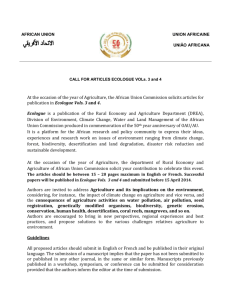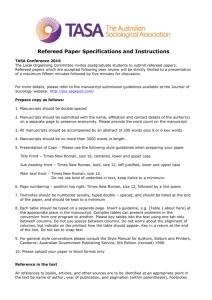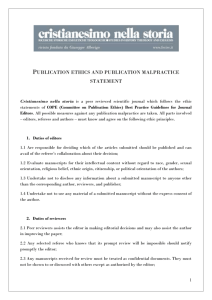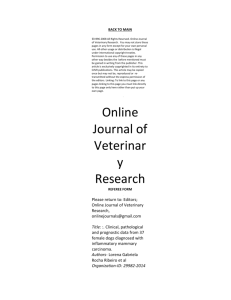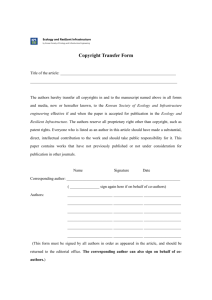instructions to authors
advertisement
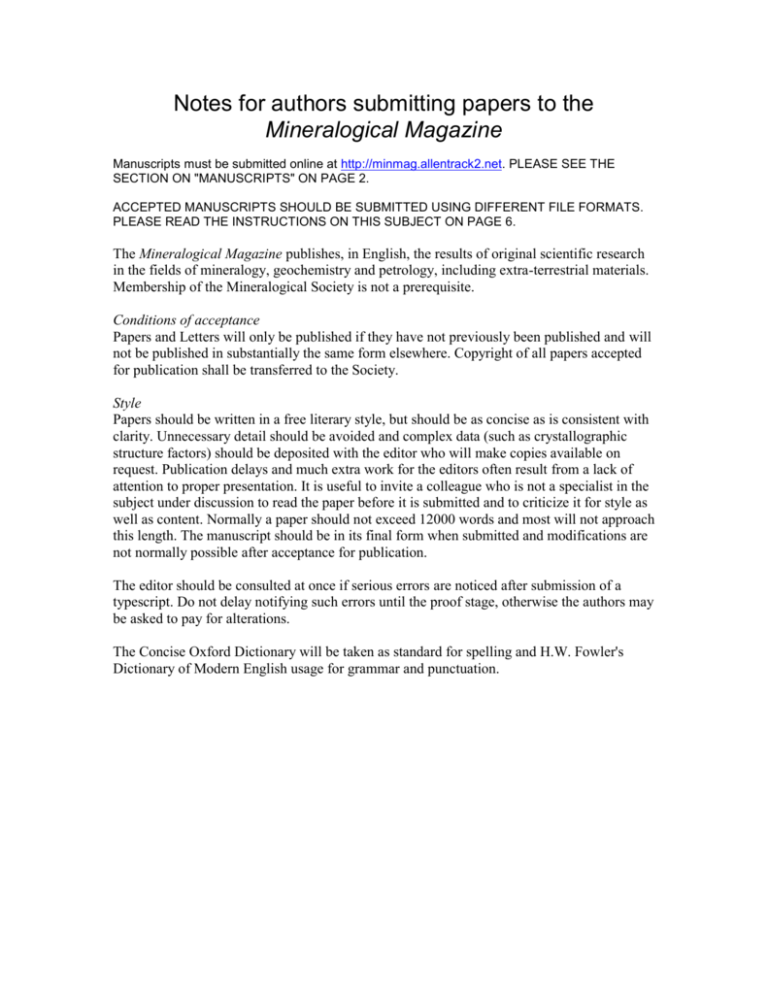
Notes for authors submitting papers to the
Mineralogical Magazine
Manuscripts must be submitted online at http://minmag.allentrack2.net. PLEASE SEE THE
SECTION ON "MANUSCRIPTS" ON PAGE 2.
ACCEPTED MANUSCRIPTS SHOULD BE SUBMITTED USING DIFFERENT FILE FORMATS.
PLEASE READ THE INSTRUCTIONS ON THIS SUBJECT ON PAGE 6.
The Mineralogical Magazine publishes, in English, the results of original scientific research
in the fields of mineralogy, geochemistry and petrology, including extra-terrestrial materials.
Membership of the Mineralogical Society is not a prerequisite.
Conditions of acceptance
Papers and Letters will only be published if they have not previously been published and will
not be published in substantially the same form elsewhere. Copyright of all papers accepted
for publication shall be transferred to the Society.
Style
Papers should be written in a free literary style, but should be as concise as is consistent with
clarity. Unnecessary detail should be avoided and complex data (such as crystallographic
structure factors) should be deposited with the editor who will make copies available on
request. Publication delays and much extra work for the editors often result from a lack of
attention to proper presentation. It is useful to invite a colleague who is not a specialist in the
subject under discussion to read the paper before it is submitted and to criticize it for style as
well as content. Normally a paper should not exceed 12000 words and most will not approach
this length. The manuscript should be in its final form when submitted and modifications are
not normally possible after acceptance for publication.
The editor should be consulted at once if serious errors are noticed after submission of a
typescript. Do not delay notifying such errors until the proof stage, otherwise the authors may
be asked to pay for alterations.
The Concise Oxford Dictionary will be taken as standard for spelling and H.W. Fowler's
Dictionary of Modern English usage for grammar and punctuation.
Manuscripts
These must be submitted online at http://minmag.allentrack2.net. and supplied with double
line spacing throughout, with ample (4 cm) margins. The text (including title, headings and
subheadings) should be in lower case except for initial letters of personal and place names.
Please refer to a recent issue of the Journal for the requisite layout, especially for the title,
authors' names and addresses, abstract and references. Please see p. 6 for file formats etc.
Letters
‘Letters’ offer authors the opportunity to have important new work reviewed and published
quickly. A review will be sent to the authors within four weeks of receipt of the paper and
accepted letters will be published within 1–2 months. Letters will not normally exceed 4000
words or 5 printed journal pages (including figures and tables).
Short Communications and Mineralogical Notes
Both of these formats were discontinued from 1 January 1998.
Manuscript
Title
Only papers containing a significant element of new information will be published and the
titles of all papers should reflect this. Papers merely reporting new occurrences of a
previously discovered mineral will not normally be considered for publication unless
adhering to the first condition in this paragraph. The editor’s decision will be final in this
regard. An alternative avenue for publication may be suggested in such cases.
Abstract
An abstract of not more than 400 words, and preferably less, must accompany all Papers and
Letters. This should state the principal results of the work, conclusions drawn and new
mineral names proposed. New data presented should be mentioned.
Headings
Normally a maximum of three levels of sub-heading is used: the major sub-heading is printed
in bold and ranged left, the second order is italic and ranged left, and the third order indented
and italic and followed on the next line by indented body text. All headings should be given
in lower case.
Data
These should not be repeated from the literature unless they are from inaccessible journals
and are discussed in the text. It may be appropriate for papers on rare or obscure minerals to
contain a concise summary of available data. SUBMISSIONS CONTAINING DATA ON
NEW MINERALS OR CRYSTAL STRUCTURES MUST INCLUDE A .CIF
(CRYSTALLOGRAPHIC INFORMATION FILE) TO BE CHECKED BY THE EDITORS
BEFORE SENDING OUT TO REVIEW. The publication of new data is encouraged,
although certain large data sets, as mentioned earlier, may be filed with the editor. X-ray
powder diffraction data will normally only be published for new minerals, for new
compositions in an isomorphous series, or when they are an improvement on those already in
the Powder Diffraction data file. Where powder data are used for identification, a statement
that they are very similar or identical with those in the literature is sufficient.
Numbers
Large numbers and very small numbers should either be quoted in the form of powers or by
grouping the digits in threes without the insertion of commas. With decimal numbers less
than 1, the zero before the decimal point must be included.
Tables and illustrations
Figures and tables should be kept to a minimum and will only be printed if essential. Tables
should be prepared or saved using a word processing package with entries in adjacent
columns separated by tabs. Authors should use footnotes to the tables to provide ancillary
information rather than add such text to the title.
Since use of authors’ electronic figures for publication became common, we have
encountered many difficulties with file type, image size, image format and image resolution.
Please follow the guidelines below closely when creating your figures.
1. The following formats are acceptable: .tif, .bmp, .eps, .ai (Adobe Illustrator) and .cdr
(Corel Draw). Do not send figures which are embedded in MS-Word or other Microsoft files.
2. Line diagrams must be saved as 1-bit, i.e. bitmapped, or as vector images. Drawings which
include grey shading must be saved as greyscale images. Photographs (otherwise known as
halftones) must be saved as greyscale images. Reproduction of colour figures in
Mineralogical Magazine is free of charge. If we are to print a figure in colour, use CYMK as
the colour type rather than RGB.
3. Line diagrams and greyscale drawings must have a resolution of at least 600 dpi.
Photographs (halftones) must have a resolution of at least 300 dpi. (This applies whether
colour is involved or not.)
Bear in mind that the physical size of reproduction of an image and its resolution work hand
in hand. An image which has a resolution of 600 dpi, but which is saved at 2 cm wide, will
only have a resolution of 120 dpi if it is to be published at 10 cm width.
4. For legends and other labelling on figures, use Arial or similar sans-serif font. Keep in
mind the final size of reproduction of the figure when choosing the font size, i.e. make sure
that the final size will be neither too big nor too small, and try to achieve some consistency
between each of your figures. Do not use italic for anything other than variables. Do not
italicize Greek letters.
5. When creating your e-files remember to embed all fonts in all figures (e.g. in Corel Draw
and Adobe Illustrator). If you don’t, we won’t be able to read any text you add to the figures
unless your fonts match exactly those we have on our computers.
Remember, if the images you send do not look clear and sharp to you, they won’t be usable
for publication. If you are unable to match these instructions exactly and produce clear sharp
images at the appropriate resolution etc., then please arrange, at an early stage, to create highquality printed versions of your figures (print them from the original software in which they
were created on high-quality glossy paper) and send them to the editor.
Footnotes
These should be avoided where possible. When necessary, they should be inserted on the
same manuscript pages as the passage to which they refer.
References
These should be supplied in double line spacing. Experience has shown that in many
typescripts the references have not been checked. No reference should be cited that has not
been seen by the author, unless it is distinguished by square brackets and the source seen is
quoted. References are arranged alphabetically, although some historical papers may give
them in chronological order with the date first. For several publications of an author with
different co-authors the following order must be followed: (a) publications of the author
alone, in chronological order; (b) publications of the author with a single co-author, in
alphabetical order of co-authors; (c) publications of the author with more than one co-author,
in chronological order (as they are cited in the form `Jones et al.' in the text). Authors must
check that all references listed are cited correctly in the text, and vice-versa. The titles of all
papers must be included in the references and should be exactly as in the original. A
translation should be appended in the case of Teutonic or Romance languages. References
that have gone through many editions under different editors should be referred to under the
original author (e.g. Dana's System of Mineralogy). Journal titles must be given in full in
the reference list.
Mineral Names
New mineral names will not be finally accepted for publication until they have been
approved by the Commission on New Mineral Names of the International Mineralogical
Association. Papers including new names may be accepted provisionally, pending the
Commission's decision. Names of rocks and minerals should not be written with initial
capitals.
Place Names
These should not be abbreviated. It should always be possible to find them in a good atlas.
Mathematical Expressions
These are often written in a form unsuitable for printing. Short, simple expressions and
equations should be set on a line with the text unless they are numbered, when they should be
on lines of their own. Fractions should normally be written with the solidus (/) and all
algebraically necessary brackets must be used. A common error is to write Fe/Fe+Mg for
Fe/(Fe+Mg).
Chemical Formulae
Note that a subscript number outside parentheses multiplies everything inside the
parentheses. Thus (Fe1.5Mg0.5)2 means Fe3Mg; the correct form is (Fe1.5Mg0.5)2.0. Ionic charge
is indicated by a superscript plus or minus sign following the symbol for the ion; for multiple
charges an Arabic superscript numeral precedes the sign, e.g. K+, Fe3+.
Hyphens
These often cause trouble; they are necessary between the members of a compound adjective
(‘the unit-cell contents’, but ‘the unit cell contains’, and ‘high-temperature polymorph’ but
‘reaction at high temperatures’). Double barrelled names or adjective noun pairs cannot be
hyphenated (‘the boundary between New York and New Jersey’ not ‘the New York-New
Jersey boundary’). In lists of minerals in parageneses and associations a hyphen with spaces
before and after will be printed as an en-rule.
Diacritical Marks
Diacritical Marks (accents, umlauts, etc.) should never be omitted, nor should the German
modified vowels be written as ae, oe, and ue unless they are so written in the original. Both
forms are used in personal names.
Symbols, Units and Abbreviations
The International System of Units (SI) is to be used, although certain widely used and
convenient derived or special units are retained: e.g. centimetre, Ångstrom, litre, calorie and
kilocalorie, bar and kilobar (the latter must be abbreviated as kbar). The micron is replaced
by the micrometre and the millimicron by the nanometre. Millions of years are denoted Ma
(or m.y.). Sides and angles of the crystallographic unit cell are denoted a, b, c, a, b, c, (not a0,
b0, c0, etc.). Co-ordinates of atoms in a crystal structure are given as fractions of the cell
sides: x, y, z. Crystallographic axes are also labelled a, b, c (in the hexagonal system a1, b2,
c3, c). The Miller axes should be used for crystals having a rhombohedral lattice. The
Hermann-Mauguin symbols should be used for the 32 crystal classes and the 230 space
groups; the Schoenflies symbols may be added if desired. If the space group has been newly
determined or re-determined, the systematic absences should be cited as well as the spacegroup symbol. All the X-ray spacings should be given in Å; when quoting from old data, care
should be taken to ascertain whether the units are true Å or kX (Siebahn units). Face-indices
are enclosed in parentheses ( ), form-indices in braces { }, zone-indices in brackets [ ], a form
of zones in carets < >, while X-ray diffractions are not enclosed. When hexagonal indices are
given the third index should not be omitted and, where one index exceeds 9, it should be
written as e.g. 4.6.10.0. Refractive indices and principal axes of indicatrix are a, b, c, (biaxial
crystals), e and v (uniaxial crystals) n (isotropic material). The true optic axial angle is
2Vor 2Vnot 2V-- or 2V+. This angle measured in air is 2E and, in an immersion medium,
2H. Dispersion of the angle is written v > r, meaning that the angle for violet is greater than
for red. Extinction angles should be recorded as in the following example `(110),
c':[001] = 10º in the obtuse angle [001]:[110]. Normative symbols should be those defined
by the authors of the normative system, e.g. Cross, Iddings, Pirrson and Washington (Journal
of Geology, 1902) but where the norm is less familiar the abbreviation should be defined.
Other widely used contractions may be employed but ad hoc contractions should have at least
three letters.
Other abbreviations and symbols
P
pressure
V
volume
T
temperature
D
density
REE rare-earth elements
I/I0
relative intensity
d
interplanar spacing
Fe-K radiation
||
p.
pp.
c.
calc.
meas.
obs.
vs.
et al.
i.e.
e.g.
cf.
parallel to
page
pages
circa
calculated
measured
observed
versus
et alii = and others
id est = that is
exempli gratii = for example
confer - compare
Electronic submission of manuscripts
MS Word or equivalent is the only acceptable format for the text and tables. For
figures, all line diagrams must be of at least 600 dpi resolution and for half-tones
(photographs) the resolution must be at least 300 dpi, at the size of final reproduction.
The acceptable file formats are .tif, .bmp, .eps, .ai (Adobe Illustrator), .psd (Photoshop)
or .cdr (Corel Draw). Note that you may choose to embed your figures in your Word
document prior to uploading in our online submission system, or you can opt to upload
them separately, and have the system process them. The system will not allow upload of
pdf files which you have prepared.
